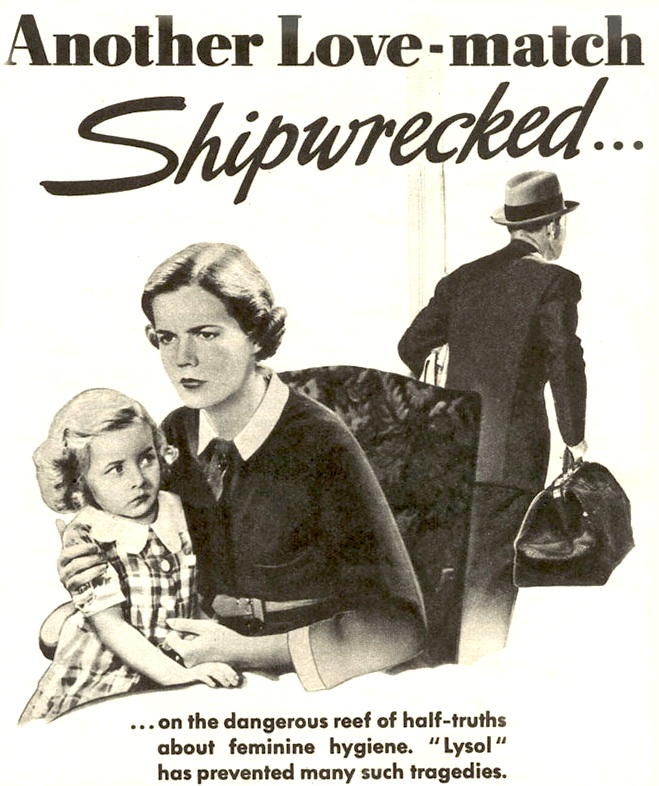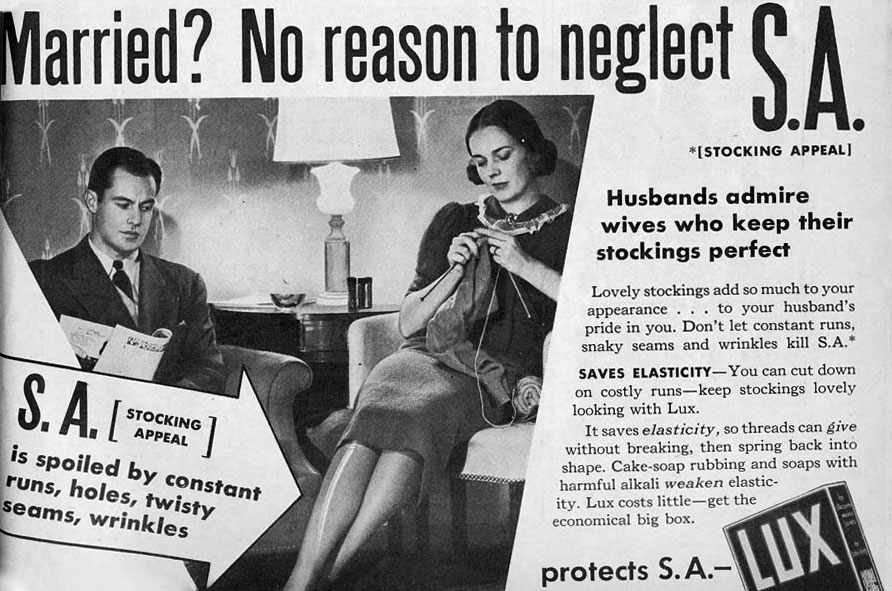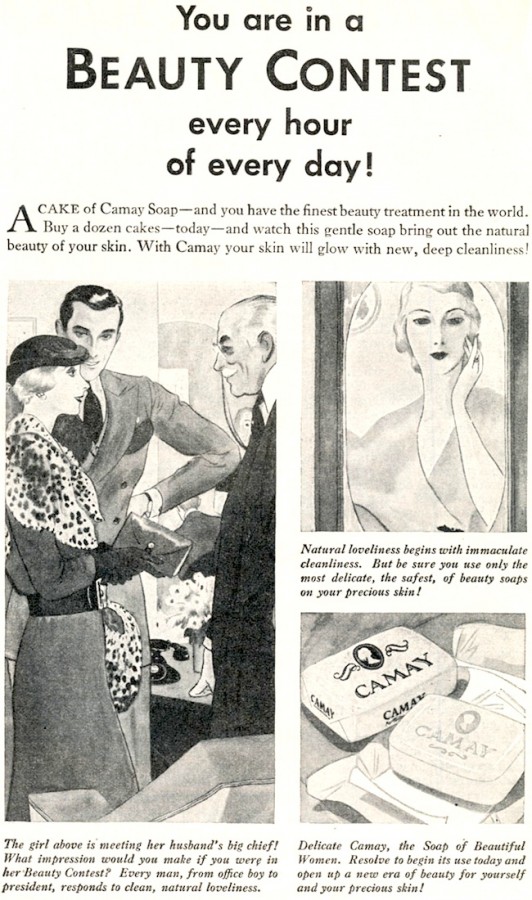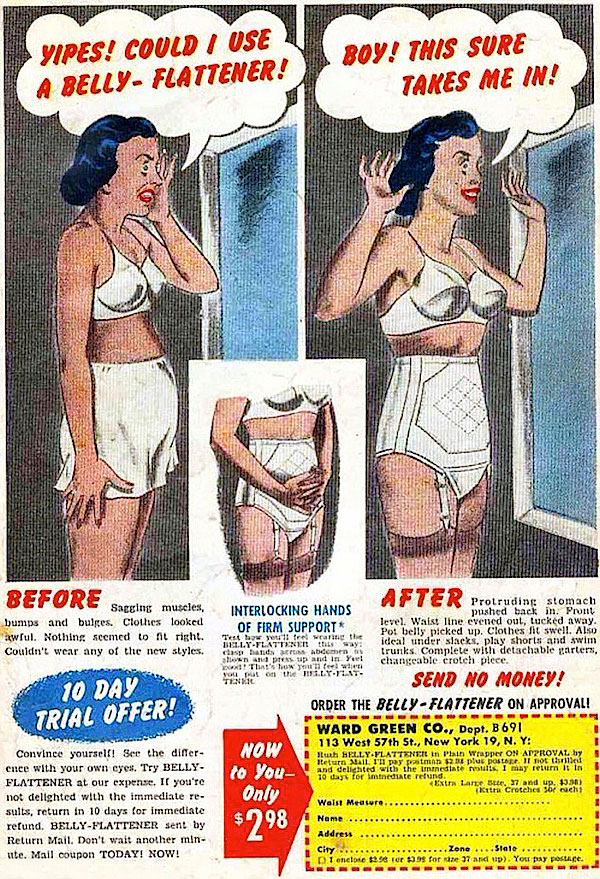Old 1950s Commercials Women Must Wear Dresses

One vintage ad warns women, "Don't let them call you SKINNY!" while another promises that smoking cigarettes will keep one slender. If the task of morphing their bodies into the current desirable shape isn't enough of a burden, women are also reminded that they stink.
"You're stuck at the party with a ripped stocking, and it'll probably end your marriage."
In these vintage ads, a woman may be emitting a foul odor from any body part—her armpits, her mouth, her hair, her hands, her lady parts—but she never knows it until her husband is walking out the door, suitcase in hand. And what about her skin? According to such ads, she might drive that man away with her so-called coarse pores, old mouth, tan lines, zits, wrinkles, middle-age skin, hairy legs or lip, visible veins, or horror of all horrors, dishpan hands.
The Do I Offend? blog chronicles such vintage body-shaming advertisements geared toward women, and the baffling shifts from one feminine ideal to the next. Cynthia Petrovic, a Southern California artist known as RedTango who designs and sells a retro-themed gift line, got hooked on these advertisements when she was in college. Now, she has a garage full of antique and vintage magazines, which she's been slowly pilfering for the most sexist (and funniest) ads targeting women.
For the past couple years, she's been uploading these ads to Do I Offend?, where she adds a snarky headline and sorts them into categories like "A Weighty Matter," "Toilet Torment," and "No Boob Left Behind." We talked to Petrovic about her collection and what she's learned about how the ad men on Madison Avenue have gotten rich selling women shame.
Collectors Weekly: How did you first get interested in these ads?

Above: An example from a series of 1930s Waldorf ads about bad toilet paper ruining family life. Click image to see the larger version. Top: Without the right deodorant, this Odo-ro-no ad admonishes, one's physical appeal is rendered worthless.
Petrovic: When I was in college, I came across a 1930s romance magazine called "True Story" in an antiques store in Orange, California. Flipping through the pages, I found an ad for Waldorf toilet paper, which was a little comic strip. A man has become so cranky toward his wife that their marriage is on the rocks. As it turns out, cheap toilet paper is the thing that's driving him crazy because it has bits of splinters in it. The couple holds the tissue up to the light, and they see little pieces of wood in it. Waldorf advertised repeatedly in these magazines. In some of the ads, the wife was cranky, and then it was their little girl. Eventually, the whole family was affected by this scourge. I found it so funny.
After that, I got addicted to finding these old romance magazines from the '30s and '40s—"True Romance," "True Story," and "True Secrets"—as well as the homemaking magazines like "Woman's Home Companion" and "Ladies' Home Journal." But the romance magazines were where I found the ads that really take the cake. They're the most entertaining, and just shameless. The most common premise is that a woman does not want to offend a man. These ads speculate about whether your husband is going to walk out on you because you're not using a feminine hygiene product or your scalp smells when you're dancing or you have undie odor.

In the 1930s, dancing was an important social activity, and shampoo companies wanted women to worry about yet another way they could smell bad.
It's a laugh to look at how ridiculous these ads are, but the appeal goes beyond the humor. I also have an interest in sociology and psychology, particularly the way we advertise to women and how women are treated by the media in general. I think we, as a society, are extremely cruel to women. I look at these old ads and feel as though nothing has changed. Which is sad because my mom used to go to the women's lib rallies back in the '70s, and 40 years later, we're worse off. We don't have the same little comic strips making fun of women, but there is still intense pressure for women to fit in, not to offend people, not to be ostracized. In the old ads, you can offend people in myriad ways, with runs in your stockings, by your hair smelling, with bad breath, with your underarm odor. But today, every inch of a woman's body is scrutinized, especially when it comes to weight.
Collectors Weekly: What prompted you to start a blog about these ads?
Petrovic: I ended up with piles of these vintage magazines stacked up in cupboards in the garage. At one point, I looked at the piles and thought, "If people out there are going to find this interesting and funny, why not share it?" I wanted to do something with it. If it's going to take up that much space in my life, I should make it useful. What you see on the website now doesn't even begin to scratch the surface of what I've got to upload. And that's a year and a half's worth of me getting on the computer several times a week to scan and upload the ads to the site.
Collectors Weekly: When did this sort of advertisement begin?

Ads in 19th century magazines sold devices to reshape one's face.
Petrovic: The mass media that breeds insecurity in our culture started in the late 1800s with the spread of magazines. I've got ads going back to the 1890s, which offer a lot of contraptions to change your face. The Victorians were really into things that you strap on your face to lift your chin and reform your nose. Every age has its neurotic beauty fixations. They also wanted tight, little waists and the big butts formed by corsets, as well as long, beautiful hair.
"Those ads didn't say you can use Lysol as a douche and to clean your floor. Now, we're just cleaning floors with it."
In the late 19th century, magazines took over the advice and care of your family. As magazines were available to more and more people, you could read about what to buy, how to take care of your kids, what you should look like, and what you should be thinking and doing. People turned to the magazines to get information and form opinions about themselves. Suddenly strangers were telling people what they should look like, buy, and think. Today, that's exploded with the Internet.
I noticed a fever pitch building up during the 1930s. By the late '30s, the advertisers were on a roll. You open up any of these magazines now, and you burst out laughing. But during World War II, I would say about 80 percent of those ads that manipulate you, the ones that say you stink or you're not socially acceptable on some level, vanished.
Collectors Weekly: On your home page, you talk about how these ads induce shame, guilt, and paranoia.

Lysol disinfectant, which was sold as a douche in the '30s, produced endless ads showing a man leaving his wife over unspeakable "feminine hygiene" problems.
Petrovic: Yeah, because when you feel good about yourself, you don't buy stuff. Paranoia, fear, inadequacy—that all sells products. It's also a part of the ad's job to create and continually foster an environment where you're perpetually terrified into purchasing things that don't work.
Collectors Weekly: According to vintage ads, what are some of the consequences of not using these products?
Petrovic: One is, of course, you'll be lonely and you won't have any dates. That's the worst. The second is that your female friends will talk about you behind your back because you stink. In the 1930s, ads would have a little photo of the bridge game, and the women are whispering, "Oh God, I wish she used deodorant." The third is that you will not get jobs. You'll be passed over for promotions because the boss really thinks that you smell, but he's not going to say anything. A lot of these ads were done during the Depression so you had women desperately trying to get work. Somebody finally tips them off that they need to take a bath because they stink. I'm not saying that this is all ridiculous. There might be some truth to it, but it's magnified to the point where a woman is taught to blame herself for everything.
Collectors Weekly: Maybe these companies were also acting out of desperation, thanks to the Depression.

When women got thin due to hunger during the Depression, the slender, straight flapper silhouette went out of style. Ironized yeast products promised "skinny" women "weight," by which they meant larger hips and breasts.
Petrovic: Maybe it was desperate. The economy is tied intrinsically to sexuality, and I like exploring exactly how that works. When there's less food, heavier people are considered attractive. When you've got a lot of food, skinnier people are more attractive. Products that help you put on weight became trendy during the Depression. If you look a little more filled out, you don't look like you're deprived.
I am trying to scan and put the body-image variables on the site. Some ads say "Oh, she's a beanpole. Look at her! She's too skinny." In the comics, the guys are like, "Forget it. I don't even notice her." Now she's put on some weight? Oh, yeah, all the men are flocking around. And then there are ads telling you that you need to get rid of the weight because you've got to be thin. You can't keep up. What is it today? What am I supposed to look like now? People don't have the capability to constantly morph into something new – oh, that's not in style? Okay, let me flatten my boobs or let me pump my boobs up. Let me get rid of my butt. Now, I'm going to inflate my butt.
Collectors Weekly: I've noticed the weight you supposedly gain from products like Wate-On never goes to an undesirable place, like the belly.

Strangely enough, this 19th century device promised to shrink the bust. Perhaps some breasts were considered too disproportionately large for the Victorians' hourglass ideal?
Petrovic: It always goes right to the chest and the butt, because ads are fantasy. What will happen when your purchase this product and slather it on? Men are lied to as well, especially with beer. That's the big thing: If you drink this kind of beer, the women are going to come flocking. The fantasy of advertising is not entirely geared toward women, but largely it is.
Collectors Weekly: I noticed that in a lot of these ads, the women also had to impress their husband's friends or their husband's bosses.
Petrovic: That theme comes up a lot in the food section of my website, "Hell's Kitchen." That's also about saving money. You've got to be very budget-oriented, but still prepare a classy dinner so that your husband feels as though this is a meal "fit for a king." Even on your tight budget, you are expected to put on a nice meal for when the boss comes over because your husband will get the promotion if your corned beef is perfect and money-saving.

"Husbands admire wives who keep their stockings perfect." In the 1930s, advertisers wanted women to worry about their "S.A." or "Stocking Appeal."
She had to keep her personal appearance up, too. Oh, my God, the horrors! The woman's stocking runs when the couple is in the middle of a party, and you won't believe the sneering looks from the husband. It's as if she's lying in the gutter. A run in the stocking is something you can't help sometimes, and people's disgusted expressions in the ad are completely disproportionate. "Ew, you've lost stocking appeal!" The advertisers would come up with these insulting little catchphrases, like "S.A.," or "stocking appeal."
Keep in mind, during the Depression women didn't have a lot of extra money to spend on another pair of stockings. Oh, my gosh, it's torn! What are you going to do? You probably can't go to Rite-Aid, because there were no Rite-Aids open at 9 or 10 p.m. back then. You're stuck at the party with a ripped stocking, and it'll probably end your marriage.
Collectors Weekly: In addition to stocking tears, it surprised me what a big deal "dishpan hands" were back then.

In 1930s ads, "dishpan hands" threatened marriages. Click image to see the larger version.
Petrovic: It's something nobody ever talks about these days, dishpan hands. I remember back in the early '70s, an ad for Palmolive showed a woman dipping her hands in the dish water because their soap was supposed to be a beauty treatment at the same time. Besides things like Palmolive, we also have dishwashers now, so advertisers had to try some other way of marketing that product, like focusing on convenience. Back in the 1930s, a wife's hands spent a lot of time in hot water, but she had to stay beautiful.
Also, big pores were really terrible for some reason. Anxieties go in and out of style, and people were hooked on having attractive pores for a while. We've always got to find something new to worry about. Today, the focus is your stomach, which has to be punched back into shape. We come up with new terms to make fun of body parts, like "cankles" and "bingo wingos," and then we start using them. "I can't go out in my swimsuit because I've got bingo wingos." We accept it and adopt it as reality.
Collectors Weekly: It's amazing how many different ways you can smell bad.

In this ad, pretty Joan has no idea why she's so unpopular. At night, her undergarments gossip about her careless washing habits and the odor they've been emitting.
Petrovic: Yeah, the advertisers got really creative with that in the 1930s. As a bonus, they've also instructed you on how to do the "armhole test" so that you can smell your own funk and determine whether you're acceptable or not for a night out. Maybe people just didn't wash as much—which brings me to my favorite ad.
This one is the prize, the reason why I collect these, a crowning achievement. Whoever thought it up in the ad department needs an award. A woman is in bed asleep, and her underthings are hanging on a chair nearby—slip, girdle, bra. And they're whispering about her. They're saying, "She would've been more popular if she had washed us" with the soap the ad is shilling. Literally, her underwear is gossiping about her. You can't get more demented than that.
Collectors Weekly: I love how the woman is always wondering whether her husband thinks she smells bad. Why doesn't she just ask him?
Petrovic: I thought about that, too. It seems like a lot of the marital dilemmas in these ads could be solved if the couple just talked. But it's got to get to the point where he literally puts his hat on, picks up the suitcase, and rushes out the door in disgust. There are ads that illustrate that very plainly: He's going to rush out the door while she's sitting there crying into her handkerchief. Somebody else has to come and clue her in, or maybe she goes to the doctor. I don't know whether people didn't communicate and talk the same way they might now, or whether the ads would've made somebody laugh back then. I'd like to know.
Collectors Weekly: For example, would a woman's date ever be so offended if her skirt is gaping at the button?
"She's a girl in a million! Pretty and smart. Dances divinely. Can even cook. But she's ruining her chances by having 'gap-osis.'" That is, gaps where her skirt buttons. Click image to see larger version.
Petrovic: No, a guy would be amused at that. He probably wouldn't say anything because he would enjoy peeking at her underwear. He definitely wouldn't be choking on a sandwich in disgust. Men are never as critical of a woman's body as women are, whether they're talking about themselves or others.
Collectors Weekly: What are some of the most dangerous products were targeted toward women?
Petrovic: A big product that was advertised for women's personal hygiene starting in the 1920s was Lysol. In those ads, they didn't say you can use it as a douche and to clean your floor. Now, we're just cleaning floors with it. Can you imagine the injury that was done? Some of these products were toxic. From the 1930s to the 1960s, the makers of Kotex sold something called Quest deodorant powder to sprinkle on your menstrual pads, and that chemical gave women cervical cancer. Still, today, how careful are we with the beauty products we sell people? Many cosmetics even now contain known carcinogens.
Collectors Weekly: How else were women shamed about menstruation?
Petrovic: Many 1930s ads actually treat the period with a kind of maturity that flies in the face of the rest of the ads. They're telling menstruating women, "Go ahead, enjoy your life." They're showing women on horseback or doing other stuff that you probably wouldn't do: wearing white pants, playing tennis, going out to dinner, going to the theater. Early Midol ads say, "You're going to have a great time, and the pain won't bother you. Don't let your period get in the way." That's a very modern idea. This is 80 years ago, and they're telling women, "Get out and live your life." I like that. That's different from the rest of the ads that say, "You're no good. You've got to fix yourself."
Collectors Weekly: How did ads insulting women evolve in the mid-20th century?

According to Tangee in the 1930s, a woman's lips could be too red, smeary, glaring, and painted for a man to kiss.
Petrovic: Like I said, there were periods of time where the woman-shaming ads seemed to recess into the background. During wars, maybe you knuckle down a little bit, but then when the war is over, it bursts back out again. These ads resurfaced after the World War II, but from what I can tell, they matured a little bit. During the late '40s and early '50s, the ads targeting women just didn't reach the same peaks of insanity they did before the war, but you would still have ads for the Kotex and the practical stuff that you need. In the '50s and '60s, you started to see ads for breast enlargement. Then during the '70s, we underwent a big social revolution where women stood up, and said, "We're not going to be treated as objects anymore." But even then, the shaming ads didn't completely disappear. In that decade, you still had companies using those tactics to sell deodorants and breast-enhancement products.
Collectors Weekly: That early '70s ad boasting about all the attractive women who weren't good enough to become flight attendants is amazing.
Petrovic: That was right when the women's lib movement was going strong, and women were saying, "We're not going to be playing traditional female roles anymore, we're going to get out into the world, really get out in the workforce, and make our stand." Still, these ads popped up. Through all of that turmoil and social change that was going on back then, there was still this ad that says, "We only pick the prettiest women to be flight attendants." It just never dies.
Collectors Weekly: How does this sort of shaming manifest today?
The qualifications for Eastern Airlines stewardesses in the 1970s: "Sure, we want her to be pretty … That's why we look at her face, her make-up, her complexion, her figure, her weight, her legs, her grooming, her nails, and her hair. But we don't stop there." Click image to see larger version.
Petrovic: Nothing's really changed. Ads and the media still insist that you have to be physically perfect and socially acceptable to avoid embarrassment. Seriously, look at the world today. Women are more objectified than ever. It's changed form. I don't think you're going to see the same kinds of magazine ads we had back in the 1930s, but back then, people didn't have the Internet and the tremendous mass media the way we do now. What we see now are women-against-women cat fights and women being taught to hate their bodies in a different way through snide remarks in television shows, reality shows celebrating bad behavior, and trash tabloid websites. It's a different kind of assault, not just through products but also through images and memes constantly reminding women that there are other women that look better than they do.
In our gossip-obsessed culture, everybody is expected to be 20 years old forever and sexually available. Even when you're pregnant, you've got to be hot. What makes me sick is that there's no moment of a woman's life from birth to death where she's not supposed to be "on" sexually, starting with Bratz dolls and padded bras for girls to stories of women in their 60s and 70s getting breast implants. Everything is about being skinny now, because only the rich can afford to buy organic groceries at Whole Foods and do the crazy detox diets. Most overweight people are poor, because they can only afford fattening fast food. But all the ads on Facebook and all the lead stories on the covers so-called health magazines are about losing belly fat, which links them to the shaming magazine ads of the past. What's particularly brutal about the way the media beats up on women today is that it's not just in magazines, it's everywhere you look.
More Ads That Find Fault With Women
(All images courtesy of Cynthia Petrovic's blog Do I Offend? Visit her site to see more women-shaming vintage ads.)
Source: https://www.collectorsweekly.com/articles/selling-shame-40-outrageous-vintage-ads-any-woman-would-find-offensive/



























0 Response to "Old 1950s Commercials Women Must Wear Dresses"
Post a Comment